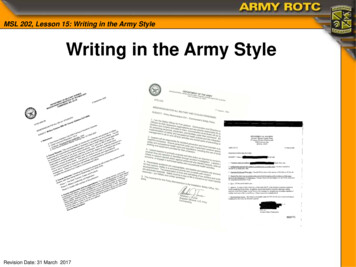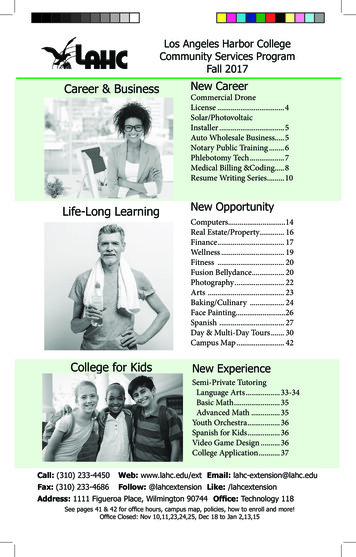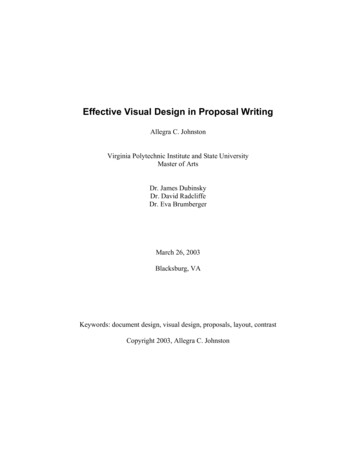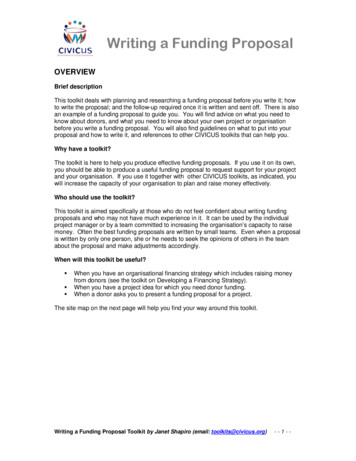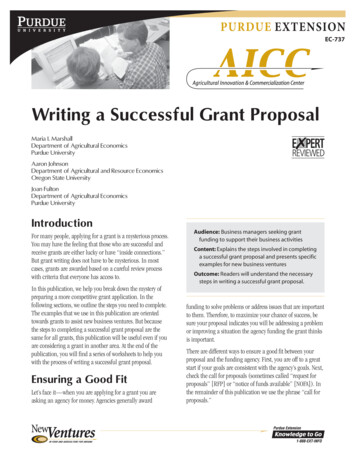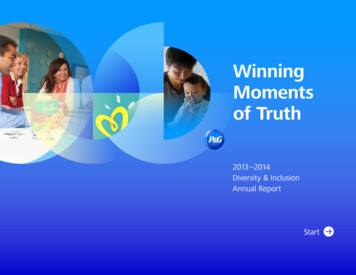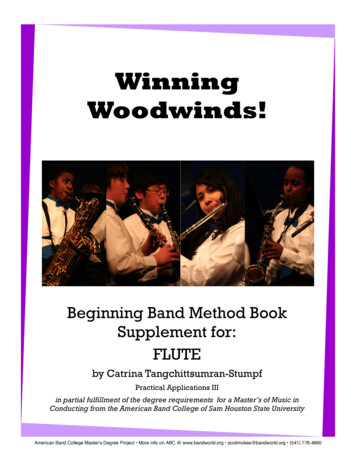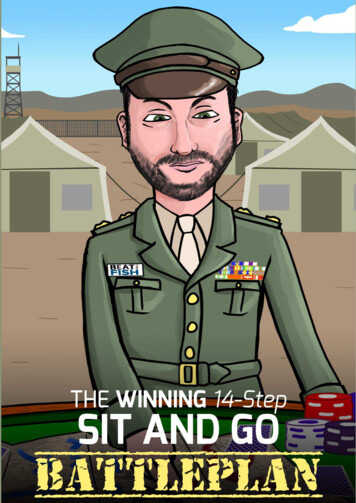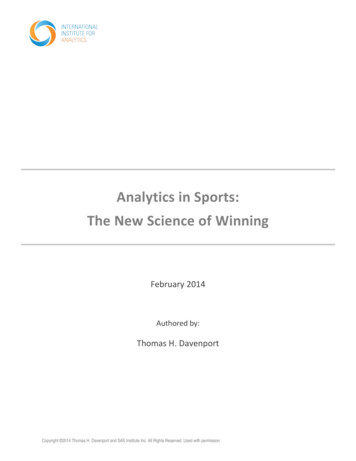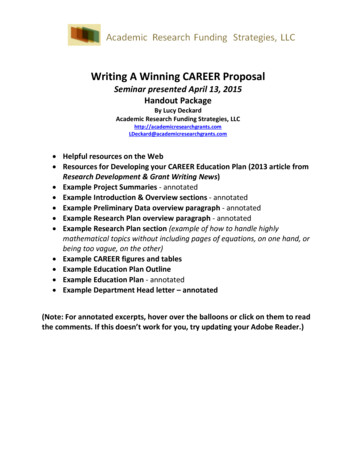
Transcription
Writing A Winning CAREER ProposalSeminar presented April 13, 2015Handout PackageBy Lucy DeckardAcademic Research Funding Strategies, micresearchgrants.com Helpful resources on the Web Resources for Developing your CAREER Education Plan (2013 article fromResearch Development & Grant Writing News) Example Project Summaries - annotated Example Introduction & Overview sections - annotated Example Preliminary Data overview paragraph - annotated Example Research Plan overview paragraph - annotated Example Research Plan section (example of how to handle highlymathematical topics without including pages of equations, on one hand, orbeing too vague, on the other) Example CAREER figures and tables Example Education Plan Outline Example Education Plan - annotated Example Department Head letter – annotated(Note: For annotated excerpts, hover over the balloons or click on them to readthe comments. If this doesn’t work for you, try updating your Adobe Reader.)
Helpful Resources for CAREER on the WebNSF Solicitation and other InfoCAREER page:http://www.nsf.gov/funding/pgm summ.jsp?pims id 503214&org NSF&sel org NSF&from fundCAREER solicitation: CAREER FAQ: ?WT.mc id USNSF 179Presentations by NSF program officer at the most recent NSF Regional Grants Conference (includingCAREER Presentation): cessful CAREER proposals on the eer/research/NSFgrants.html - 6 funded CAREERproposals related to Geoscienceshttp://valis.cs.uiuc.edu/ uic.edu/ bshipley/career.education.pdfOther CAREER dfs/NSFProposalWritingTips.pdf – Short book by Z. J. Pei,“NSF CAREER Proposal Writing Tips.” Some of the info from previous year awardees is out of date, butstill very useful informationResources for Educationhttp://www.eric.ed.gov/ - Education Resources Information Centerhttp://www.nae.edu/Projects.aspx - National Academy of cord id 11463 – National Academies Press, Rising Above theGathering Storm: Energizing and Employing America for a Brighter Economic Future (2007) (note thatpdf download is free)http://www.cur.org/publications.html - Council on Undergraduate Research, Publications pagehttp://eric.ed.gov/?id ED424840 - The Boyer Commission on Educating Undergraduates in the ResearchUniversity, REINVENTING UNDERGRADUATE EDUCATION: A Blueprint for America's Research Universities(1998) – old, but classic (pdf download is free)MSPnet - K-12 resourcesSTEPnet - STEM Undergrad Ed resourcesNational Center for Science and Engineering Statistics (NCSES) – statistics supporting need/motivationCAREER Workshops and Webinars by NSFhttp://www.nsf.gov/news/mmg/nsf.htm – video of mock CAREER review panel (ENG)NSF CISE CAREER Proposal Writing Workshop – Keep and eye on CISE News for next year’s date.QEM CAREER workshop – For minority junior faculty and faculty at minority serving institutions.
Research Development & Grant Writing NewsResources for Developing Your CAREER Education PlanCopyright 2013 Academic Research Funding Strategies. All rights reserved.By Lucy Deckard, co-publisher(Back to Page 1)Many PIs find that the most challenging aspect of developing an NSF CAREER proposal isdeveloping the required Education Plan. While PIs are intimately familiar with the literature andstate of the art in their research fields, they are often not well-acquainted with literature andprior work in education. Below, we’ll discuss some resources that you can use to identify STEMeducation needs, challenges, and opportunities as well as places where you can findinformation on scholarship, state of the art, and best practices related to these educationalissues. The literature and data you find there can also be cited in your proposal, creating a morepersuasive case for the need, significance, and rigor of your plan.Resources Listed in the CAREER SolicitationLook first at the CAREER solicitation for important publications and resources related tochallenges and best practices in STEM education that particularly reflect NSF’s outlook andpriorities. In Section V under Education Activities, you will find eleven different resources.Seven of these are National Research Council reports; three are websites affiliated with variouseducation and outreach initiatives; and one refers to NSF’s User-Friendly Handbook on ProjectEvaluation. A quick description of each and how they might be used is provided below. National Research Council. (2000). How People Learn: Brain, Mind, Experience, andSchool. Committee on Developments in the Science of Learning. Bransford, J.D., Brown,A.L., Cocking, R.R., Editors, with additional material from the Committee on LearningResearch and Educational Practice. Donovan, M.S., Bransford, J.D., and Pellegrino, J.W.,Editors.This classic report is often cited in NSF solicitations and in education-related proposals to NSF. Youcan find this report online here (click “download free pdf”). It provides an accessible overview of theresearch conducted up to the publication date on the science of learning and how that research canbe translated to classroom practice. Of particular interest for faculty, this report discusses theevidence supporting the effectiveness of inquiry-based and active learning. They also discusssuperficial versus deeper learning, the influences of culture and community on learning, andassessment. While this report focuses more on K-12 students, many of the principles discussed alsoapply to undergraduates. National Research Council. (2001). Adding it up: Helping children learn mathematics.Mathematics Learning Study Committee. Kilpatrick, J., Swafford, J., and Findell, B.,Editors.You can find this report here. This report focuses on math learning by pre-K through 8th gradestudents.18
Research Development & Grant Writing News National Research Council. (2001). Knowing what students know: The science anddesign of educational assessment. Committee on the Foundations of Assessment.Pellegrino, J., Chudowsky, N., and Glaser, R., EditorsYou can find this report here. It discusses various kinds of educational assessment and the value ofinforming assessment with new understandings of cognition, memory, and learning. Some of thismaterial could be helpful in planning how you will evaluate your education activities. National Research Council. (2002). Scientific research in education. Committee onScientific Principles for Education Research. Shavelson, R.J., and Towne, L., Editors.You can find this report here. This is a relatively high-level report on the science and practice ofeducation research; it does not address specific results of education research. National Research Council. (2007). Taking Science to School: Learning and TeachingScience In Grades K-8. Duschl, R. A, Schweingruber, H. A, and Shouse, A. W., Editors.You can find this report here. As the title suggests, this report discusses science teaching and learningfrom K through 8th grade levels. This may be helpful in planning an outreach component for thisgroup of students. National Research Council. (2009). Learning in Informal Environments: People, Places,and Pursuits. Bell, P., Lewenstein, B., Shouse, A. W., and Feder, M. A., Editors.You can find this report here. It may prove useful for planning science outreach activities. National Research Council. (2010). Surrounded by Science: Learning Science in InformalEnvironments. Fenichel, M. and Schweingruber, H.A., Editors.You can find this report here. This is a comprehensive and accessible guide to designing andassessing informal science environments such as those you might develop for an outreach activity. Council of Graduate Schools, Broadening Participation in Graduate Education (2009).You can find this report by the Council of Graduate Schools here if you are a member (or order it ifyou aren’t). This report discusses the need to increase diversity and inclusiveness in graduateeducation. National Lab Network – website for NLN, a national initiative that connects K-12teachers with STEM professionals.Broadening Participation in the Computer Sciences Portal – This website should be herebut was not working at the time of writing this article.The 2002 User-Friendly Handbook for EvaluationThis handbook can be found here. It gives a comprehensive guide to project evaluation and isgenerally meant for much larger projects than those in a CAREER education component. However, a19
Research Development & Grant Writing Newsquick read (particularly Section II, Chapter 3) could be useful to familiarize yourself with the generalprinciples, methods, and terms used in project evaluation.Other Helpful Resources The Boyer Commission on Educating Undergraduates in the Research University,REINVENTING UNDERGRADUATE EDUCATION: A Blueprint for America's ResearchUniversities (1998)This older but highly influential report describes the challenges and needs for improvingundergraduate education, particularly STEM education. It is frequently cited by NSF and byproposals to NSF. You can find this report here. National Academies Press, Rising Above the Gathering Storm: Energizing and EmployingAmerica for a Brighter Economic Future (2007).Another highly influential report on needed reforms in education particularly related to theimportance of STEM education. You can find that one here. Education Resources Information Center – searchable database of education researcharticles. Very accessible to those who lack expertise in education research. Great place tostart your literature search. The MSPnet Hub – This is the website for NSF-funded Math and Science Partnerships. Itcontains a wealth of information on projects, lessons learned, resources, andpublications coming out of these NSF-funded projects aimed at improving K-12 STEMeducation. This information can be especially useful because NSF likes to see researchersusing and building on successful approaches developed by other NSF-funded projects. STEPCentral – Similar to the MSPnet, this website provides a portal to resources andlessons learned by NSF-funded STEP (STEM Talent Expansion Program) projects, whichfocus on increasing numbers, success, and diversity of STEM undergraduate students. National Academy of Engineering Center for Advancement of Scholarship onEngineering Education – You can find information on CASEE projects and read theirreports online. Their “resources” page also features workshop materials and videos. Council on Undergraduate Research – Information on new models and best practices forundergraduate education. Pay special attention to their “publications” page. National Center for Science and Engineering Statistics – This is a good place to look fordata to support the need for more STEM students and graduates at various levels as wellas the need for increased diversity. On the above site, you’ll find the Science and Engineering Indicators 2012 Report, whichbrings together a lot of data on STEM education, labor force and R&D trends.20
HandoutCAREER PROJECT SUMMARY EXAMPLE AWARDED 2006Jairo Sinova, Department of Physics, Texas A&M UniversitySECTION A- SUMMARY: This five year career-development plan (CDP) is an integratedresearch, education, and outreach program that focuses on the study of spin-dependentphenomena in semiconductors at multiple length scales. This CDP has four main goals:1. To develop a theory of spin transport and accumulation in spin-orbit coupled systems wherespin manipulation is possible solely by electrical means. This study, which encompasses thespin-Hall effect, will address key issues such as disorder scattering, generalized driftdiffusion equations, and interaction effects. Several approaches combining analytical andcomputational techniques at different length scales will be utilized;2. To obtain a systematic theory of the anomalous Hall effect and anomalous transport thattreats on an equal footing both extrinsic and intrinsic mechanisms responsible for the effect.This study will also merge different approaches to resolve the contradictory results obtainedthrough microscopic and phenomenological approaches which ultimately should be linked,forming a consistent theory;3. To further extend the theory of magneto-transport and magneto-optics in diluted magneticsemiconductors (DMS) to include nano-structures and hybrid systems and explore newphenomena such as tunneling anisotropic magneto-resistance;4. To implement an educational plan which incorporates and develops a new teaching initiativein the upper-division undergraduate curriculum, involves undergraduates in research,promotes student international collaborative research, exposes the field of spintronics to thegeneral public, and provides a resource web-site for DMS studies.Intellectual merit of the proposed activity: The proposed research plan addressesfundamental questions essential to advancements in the semiconductor spintronics field (SeS).We propose to develop a spin-transport theory for systems with intrinsic and extrinsic spin-orbitcoupling using a variety of models and approaches at multiple length scales in order to connectthe physical insights obtained through each approach into a unified cohesive picture of spintransport in semiconductors. At the nanoscale it is possible to explicitly address the effects ofdisorder on decoherence and spin-accumulation. This microscopic approach must ultimately belinked to the macroscopic length scale as it was done successfully in charge transport theory.Some of these approaches will involve non-equilibrium Green’s function calculations,phenomenological model calculations, and first principles calculations. The PI has ongoingcollaborations with leading experimental groups at Hitachi-Cambridge
SECTION A- SUMMARY: This five year career-development plan (CDP) is an integrated research, education, and outreach program that focuses on the study of -dependent spin phenomena in semiconductors at multiple length scales. This CDP has four main goals: 1. To area of researchdevelop a theory of spin transport and accumulation in spinorbit coupled systems where- spin manipulation is
